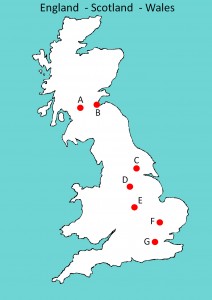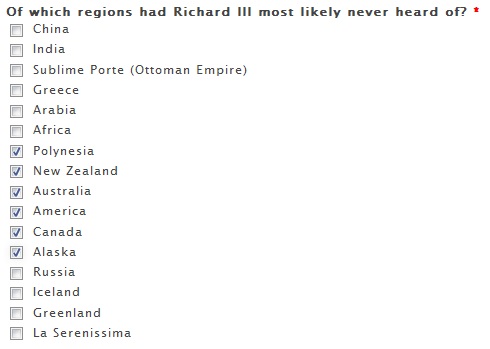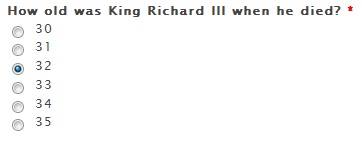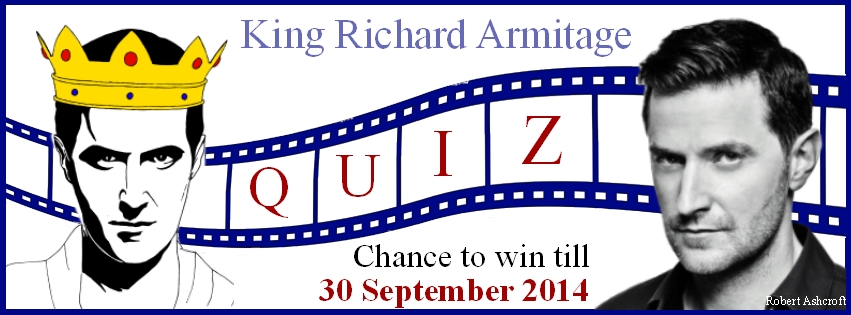KRA-Quiz Solution 2014
♛
KRA Quiz 2014 – Solutions
Question 1


E is correct, as it is the location of Leicester.
Question 2


G is correct, as the location of London / Westminster. The location where Queen Anne was buried is the chapel in Westminster Abbey.
Question 3

Queen Anne Neville died during a sun eclipse, which gave rise to the suspicion that King Richard III killed her, as even the sun would hide to show his crime.
Though at the time the astronomical reasons for a sun eclipse were widely debated and known in Europe, so such superstition was only a weapon to mobilize the uneducated part of the population. And after a reported steady decline in the health of the queen, her death might not have come as a surprise for those close to her.
Question 4

In exile with his brother King Edward IV., Richard III was in Flanders, which now is part of Belgium. Their connections and coalition debates lead them to France.
For his military siege of Edinburgh in representation of his ill brother King Edward IV., Richard III came to and fought in Scotland.
Question 5

Quite wide areas of the world were already open and known to King Richard III and his contemporaries.
All the ‘New World’ and Captain Cook discoveries were still unknown to him. While Greenland and Iceland were already known and were starting points of quite some of the discovery expeditions of the time.
Question 6

The previous question already in a way answers this one. I just could not resist …
Question 7

Well, the number of weapons and fire arms used in the Battle of Bosworth might be a thing for endless debates of researchers, but I hoped to give you a clear hint with the revolver technique, which was developed in the 19th century.
Question 8

Question 9

From the timing, King Richard III might have seen his father’s and brother’s head exhibited at the town gate of York. Though he might have entered town through another gate.
Though some argue, that much of his later fierce behaviour against enemies might be due to the fact that this encounter severely formed his personality and made him so unrelenting in securing his and his families future.
As this encounter is not documented, but in the realm of legend, both answers are correct here.
Question 10

Edward V. was King Richard III’s nephew, not his brother King Edward IV. He was one of the Princes in the Tower King Richard supposedly killed or let kill or hid or …
Question 11

Question 12

Only one battle is reported for King Richard III’s reign, unfortunately resulting in his death, the Battle of Bosworth.
But as King Richard III fought many more fights against usurpers and uprisings, this was a very difficult question for all participants and so this question was eliminated from the quiz results.
Question 13

Certainly more of his mother, who survived him, while his father died when Richard III was 8 years old.
The hint to this question was given in questions 8 and 9.
Question 14

Yes, they could marry nowadays. Even in areas where first-cousin-marriage would be banned or restricted, the fact they were 1 1/2 degrees apart, would be in their favour.
Question 15

Question 16

Had not thought that this question would be so difficult.
As Shepherd’s Pie uses potatoes, it became popular as late as the 19th century.
Stake, due to an underdeveloped fridge system, was an unusual meal in the Middle Ages as well. The trend to prepare meat this way developed in the 19th century in America, when fresh meat was directly available and more pronouncedly in the 20th century, when the fridge was invented and adequate storage of meat became possible without risking food poisoning.
For Fish & Chips the chips would have been missing for King Richard III.
If you would like to read more about food and its timeline, see: foodtimeline.org.
Question 17

Question 18

Most likely no. Even Henry VIII, who is reported to have playacted as Robin Hood, wanted to annoy his father and not reform his government.
The favourable story about Robin Hood developed later and was more and more extended by various authors to become the fairy tale legend it is nowadays.
Question 19

Question 20

The astonishing thing about finding King Richard III is, that he was found exactly on the first day of the digging. That gives some merit to the idea that he really wanted to be found.
Question 21

Mathew Morris, as the leader and supervisor over the excavation site, made the historic discovery, though not being aware at the time of the significance of the unearthed bones.
Question 22

Following Mathew Morris’ discovery of bones at the digging site, only Philippa Langley believed in their significance and fought for their proper excavation and further research.
Question 23

Yes, it is true. The King Richard III Museum does not have his name in its title.
Question 24

Richard Armitage played John Proctor in Arthur Miller’s “The Crucible” in The Old Vic theatre in London.
Question 25

Question 26

King Richard III is reported to have had hunting dogs and favourite dogs. As Richard Armitage revealed he is a ‘dog-person’ and would have a dog if his job schedule would allow it, that is a point in common between King Richard III and ‘King’ Richard Armitage.
